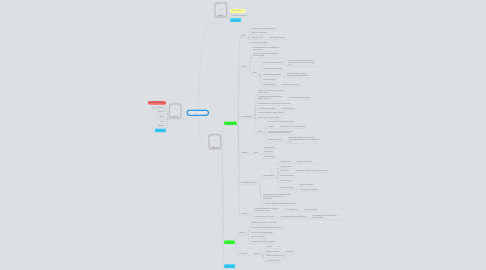
1. Step 9
1.1. Review session 2
1.2. mechanism flow chart
1.3. 20 minutes
2. Step 10
2.1. Management
2.1.1. goals
2.1.1.1. preservation of lower GI function
2.1.1.2. resection of the tumor
2.1.1.3. improving QOL
2.1.1.3.1. screening for her kids
2.1.1.4. preventing recurrence
2.1.2. surgery
2.1.2.1. the criteria should be considered for local excision
2.1.2.2. curative vs. palliative depending on the tumor stage
2.1.2.3. types
2.1.2.3.1. coloctomy with anastmosis
2.1.2.3.2. coloctomy with colostomy
2.1.2.3.3. total mesorectal excision
2.1.2.3.4. transanal surgery
2.1.2.3.5. sphincter-sparing
2.1.3. chemotherapy
2.1.3.1. adjuvant after the surgery to prevent the recurrence
2.1.3.2. for advanced metastasized tumor: stage 2 and more
2.1.3.2.1. the main treatment for stage 4
2.1.3.3. preffered for colon Ca rather than the rectum
2.1.3.4. consider the side effects
2.1.3.4.1. sexual disfunction
2.1.3.5. ensure the baseline organs function
2.1.3.6. reduces the mortality by 30 %
2.1.3.7. types
2.1.3.7.1. 5-flurouracil is the preferred regimen
2.1.3.7.2. cisplatin
2.1.3.7.3. combination improves the survival rate, but consider the toxicity
2.1.3.7.4. chemoembolization
2.1.4. radiation
2.1.4.1. types
2.1.4.1.1. external beam
2.1.4.1.2. cryotherapy
2.1.4.1.3. brachytherapy
2.1.5. multidisciplinary team
2.1.5.1. team members
2.1.5.1.1. palliative care
2.1.5.1.2. psychiatry team
2.1.5.1.3. stoma nurse
2.1.5.1.4. clinical pharmacist
2.1.5.1.5. social workers
2.1.5.1.6. family and friends
2.1.5.2. patient should be informed about the prognosis, survival, effects of medications
2.1.5.3. "total pain" should be addressed by the team
2.1.6. follow up
2.1.6.1. colonoscopy before the surgery or after the by 6 months
2.1.6.1.1. 1, 3, 5 years after
2.1.6.2. 3 and 6 months for first year
2.1.6.2.1. hx, physical examination, CEA level
2.2. Prevention
2.2.1. primary
2.2.1.1. NSAIDs might reduce the risk 37%?
2.2.1.2. diet: increase fiber and decrease red meat
2.2.1.3. lifestyle: somking and alcohol
2.2.1.4. genetic counseling
2.2.1.5. control the risk factors in general
2.2.2. secondary
2.2.2.1. screening
2.2.2.1.1. general
2.2.2.1.2. age more than 50
2.2.2.1.3. FAP and Lynsh screening
2.2.2.1.4. personal hx of IBD
